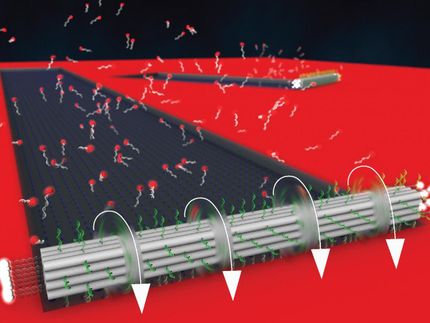Nano-walkers take speedy leap forward with first rolling DNA-based motor
Physical chemists have devised a rolling DNA-based motor that's 1,000 times faster than any other synthetic DNA motor, giving it potential for real-world applications, such as disease diagnostics.
"Unlike other synthetic DNA-based motors, which use legs to 'walk' like tiny robots, ours is the first rolling DNA motor, making it far faster and more robust," says Khalid Salaita, the Emory University chemist who led the research. "It's like the biological equivalent of the invention of the wheel for the field of DNA machines."
The speed of the new DNA-based motor, which is powered by ribonuclease H, means a simple smart phone microscope can capture its motion through video. The researchers have filed an invention disclosure patent for the concept of using the particle motion of their rolling molecular motor as a sensor for everything from a single DNA mutation in a biological sample to heavy metals in water.
"Our method offers a way of doing low-cost, low-tech diagnostics in settings with limited resources," Salaita says.
"It's the ultimate in science fiction," Salaita says of the quest to create tiny robots, or nano-bots, that could be programmed to do your bidding. "People have dreamed of sending in nano-bots to deliver drugs or to repair problems in the human body."
So far, however, mankind's efforts have fallen far short of nature's myosin, which speeds effortlessly about its biological errands. "The ability of myosin to convert chemical energy into mechanical energy is astounding," Salaita says. "They are the most efficient motors we know of today."
Some synthetic nano-walkers move on two legs. They are essentially enzymes made of DNA, powered by the catalyst RNA. These nano-walkers tend to be extremely unstable, due to the high levels of Brownian motion at the nano-scale. Other versions with four, and even six, legs have proved more stable, but much slower. In fact, their pace is glacial: A four-legged DNA-based motor would need about 20 years to move one centimeter.
Kevin Yehl, a post-doctoral fellow in the Salaita lab, had the idea of constructing a DNA-based motor using a micron-sized glass sphere. Hundreds of DNA strands, or "legs," are allowed to bind to the sphere. These DNA legs are placed on a glass slide coated with the reactant: RNA.
The DNA legs are drawn to the RNA, but as soon as they set foot on it they destroy it through the activity of an enzyme called RNase H. As the legs bind and then release from the substrate, they guide the sphere along, allowing more of the DNA legs to keep binding and pulling.
"It's called a burnt-bridge mechanism," Salaita explains. "Wherever the DNA legs step, they trample and destroy the reactant. They have to keep moving and step where they haven't stepped in order to find more reactant."
The combination of the rolling motion, and the speed of the RNase H enzyme on a substrate, gives the new DNA motor its stability and speed.
"Our DNA-based motor can travel one centimeter in seven days, instead of 20 years, making it 1,000 times faster than the older versions," Salaita says. "In fact, nature's myosin motors are only 10 times faster than ours, and it took them billions of years to evolve."
The researchers demonstrated that their rolling motors can be used to detect a single DNA mutation by measuring particle displacement. They simply glued lenses from two inexpensive laser pointers to the camera of a smart phone to turn the phone into a microscope and capture videos of the particle motion.
"Using a smart phone, we can get a readout for anything that's interfering with the enzyme-substrate reaction, because that will change the speed of the particle," Salaita says. "For instance, we can detect a single mutation in a DNA strand."
This simple, low-tech method could come in handy for doing diagnostic sensing of biological samples in the field, or anywhere with limited resources.
The proof that the motors roll came by accident, Salaita adds. During their experiments, two of the glass spheres occasionally became stuck together, or dimerized. Instead of making a wandering trail, they left a pair of straight, parallel tracks across the substrate, like a lawn mower cutting grass.
"It's the first example of a synthetic molecular motor that goes in a straight line without a track or a magnetic field to guide it," Salaita says.




















































